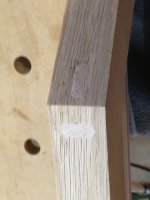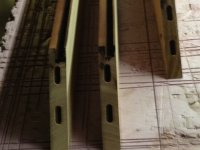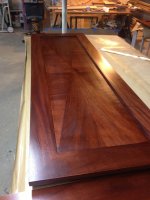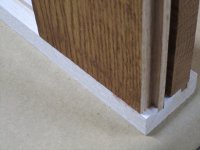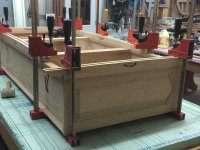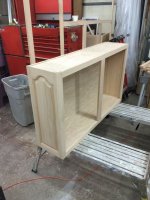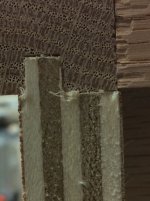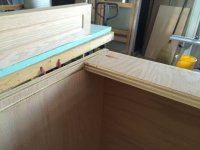I've been a Festool owner (MFT/3, T55REQ, RO150, DF500) for only about 6 months, and I think they are excellent. I recently made some frameless cabinets, jointing the 4 sides with dominos instead of the usual tongue and groove joints. The cabinets came out fine, but it sure seems like a lot more work, especially the glue up, compared to 4 tongue and groove joints. I don't understand why anyone would want to deal with all those dominos at glueup. Am I missing something?
You are using an out of date browser. It may not display this or other websites correctly.
You should upgrade or use an alternative browser.
You should upgrade or use an alternative browser.
Domino cabinet joints
- Thread starter briancc
- Start date
erock
Member
- Joined
- Apr 29, 2010
- Messages
- 1,251
Your missing pocket screws. [tongue]
Seriously, this is my opinion. Others will have there own.
But I think the combination of dominos and pocket screws make for a wicked strong joint.
The pocket screws act as the clamp. The dominos give extra strength to the joint.
That's how I prefer to make my cabinets. Using only dominos and clamps are saved for projects that I can't hide the pocket hole.
Eric
Seriously, this is my opinion. Others will have there own.
But I think the combination of dominos and pocket screws make for a wicked strong joint.
The pocket screws act as the clamp. The dominos give extra strength to the joint.
That's how I prefer to make my cabinets. Using only dominos and clamps are saved for projects that I can't hide the pocket hole.
Eric
erock said:Your missing pocket screws. [tongue]
Seriously, this is my opinion. Others will have there own.
But I think the combination of dominos and pocket screws make for a wicked strong joint.
The pocket screws act as the clamp. The dominos give extra strength to the joint.
That's how I prefer to make my cabinets. Using only dominos and clamps are saved for projects that I can't hide the pocket hole.
Eric
It would seem that, at least on upper cabinets, there are quite a few joints where you could not hide the pocket holes. I made some frameless upper cabinets for my shop using pocket holes since they were only meant to be functional, not fine cabinetry. They are strong and very functional. However, I can't see how you could hide the pocket holes. You can certainly put them inside, but that really doesn't hide them. I would agree that using Dominos for joining the sides, bottom, and top together would take a little longer, but I think the result is better in the look than pocket holes.
erock
Member
- Joined
- Apr 29, 2010
- Messages
- 1,251
grbmds said:erock said:Your missing pocket screws. [tongue]
Seriously, this is my opinion. Others will have there own.
But I think the combination of dominos and pocket screws make for a wicked strong joint.
The pocket screws act as the clamp. The dominos give extra strength to the joint.
That's how I prefer to make my cabinets. Using only dominos and clamps are saved for projects that I can't hide the pocket hole.
Eric
It would seem that, at least on upper cabinets, there are quite a few joints where you could not hide the pocket holes. I made some frameless upper cabinets for my shop using pocket holes since they were only meant to be functional, not fine cabinetry. They are strong and very functional. However, I can't see how you could hide the pocket holes. You can certainly put them inside, but that really doesn't hide them. I would agree that using Dominos for joining the sides, bottom, and top together would take a little longer, but I think the result is better in the look than pocket holes.
Well that depends on the height the cabinets are hung and the size of the cabinets.
If the pocket holes are place at the top and bottom of the cabinets then you don't see them when you open the door.
If you have 10 foot ceilings in your shop, make a 3 foot tall wall cabinets and mount the top of the cabinet to the ceiling, then yes, you'll see the pocket holes. You could plug the holes if it bothers you.
But if you're hanging the cabinets at a standard height, then you don't see the bottoms unless you bend down and look at the bottoms.
Eric
erock said:grbmds said:erock said:Your missing pocket screws. [tongue]
Seriously, this is my opinion. Others will have there own.
But I think the combination of dominos and pocket screws make for a wicked strong joint.
The pocket screws act as the clamp. The dominos give extra strength to the joint.
That's how I prefer to make my cabinets. Using only dominos and clamps are saved for projects that I can't hide the pocket hole.
Eric
It would seem that, at least on upper cabinets, there are quite a few joints where you could not hide the pocket holes. I made some frameless upper cabinets for my shop using pocket holes since they were only meant to be functional, not fine cabinetry. They are strong and very functional. However, I can't see how you could hide the pocket holes. You can certainly put them inside, but that really doesn't hide them. I would agree that using Dominos for joining the sides, bottom, and top together would take a little longer, but I think the result is better in the look than pocket holes.
Well that depends on the height the cabinets are hung and the size of the cabinets.
If the pocket holes are place at the top and bottom of the cabinets then you don't see them when you open the door.
If you have 10 foot ceilings in your shop, make a 3 foot tall wall cabinets and mount the top of the cabinet to the ceiling, then yes, you'll see the pocket holes. You could plug the holes if it bothers you.
But if you're hanging the cabinets at a standard height, then you don't see the bottoms unless you bend down and look at the bottoms.
Eric
I just differ in what I consider exposed, I guess. Mounted to the ceiling you can hide the pocket holes on the top against the ceiling I suppose. On the bottom they are never really truly hidden. As for plugging the holes, that's probably OK for shop use (which I did), but for the upstairs cabinets, plugging the holes never really gives a completely finished look.
- Joined
- Jun 24, 2007
- Messages
- 10,358
erock said:Your missing pocket screws. [tongue]
Seriously, this is my opinion. Others will have there own.
But I think the combination of dominos and pocket screws make for a wicked strong joint.
The pocket screws act as the clamp. The dominos give extra strength to the joint.
That's how I prefer to make my cabinets. Using only dominos and clamps are saved for projects that I can't hide the pocket hole.
Eric
Exactly. Pocket screws plus dominos ..... awesome!
Plus I like that the dominos keep the cabinet sides from toppling over while I assemble the box. I glue the joint but not necessarily the dominos themselves. For me they align, ease assembly, keep the pocket screws from shifting the side.
Seth
erock
Member
- Joined
- Apr 29, 2010
- Messages
- 1,251
SRSemenza said:erock said:Your missing pocket screws. [tongue]
Seriously, this is my opinion. Others will have there own.
But I think the combination of dominos and pocket screws make for a wicked strong joint.
The pocket screws act as the clamp. The dominos give extra strength to the joint.
That's how I prefer to make my cabinets. Using only dominos and clamps are saved for projects that I can't hide the pocket hole.
Eric
Exactly. Pocket screws plus dominos ..... awesome!
Plus I like that the dominos keep the cabinet sides from toppling over while I assemble the box. I glue the joint but not necessarily the dominos themselves. For me they align, ease assembly, keep the pocket screws from shifting the side.
Seth
OH YEAH! Great point Seth....the dominos help keep the pieces inline while driving in the screws. Forgot about that !
Eric
tjbnwi
Member
- Joined
- May 12, 2008
- Messages
- 7,044
I agree with the OP, when it comes to cabinet box construction, especially face frame cabinets you can't beat T&G construction, with or without pocket screws.
Before you think I don't have enough experience with the Domino, I own 3, 2 DF 500's and a DF 700 XL. Last year I plunged about 50,000 mortices and installed somewhere around 25,000 Dominos of various sizes.
This octagon window has Dominos that cross pin the corners.
A simple door fabricated with Dominos in the mitered corners.
A few T&G cabinet joints. I can insert the T'd piece to flush to the side or reverse it to create a scribe. The parts can stand on their own once put together. I've had 36" panels standing in a groove without any problems.
The T&G can be used in conjunction with pocket screws.
Every part that makes up the two cabinets were sized, shaped and sanded with Festools. The joinery is T&G because it is faster than the Domino. I did not want any visible pocket holes, the face frames were glued onto the cases.
The T&G will hold the cabinet parts aligned as well if not better than the Dominos.
To add, all of the face frame intersection have Dominos for alignment with pocket screws to hold together.
Tom
Before you think I don't have enough experience with the Domino, I own 3, 2 DF 500's and a DF 700 XL. Last year I plunged about 50,000 mortices and installed somewhere around 25,000 Dominos of various sizes.
This octagon window has Dominos that cross pin the corners.
A simple door fabricated with Dominos in the mitered corners.
A few T&G cabinet joints. I can insert the T'd piece to flush to the side or reverse it to create a scribe. The parts can stand on their own once put together. I've had 36" panels standing in a groove without any problems.
The T&G can be used in conjunction with pocket screws.
Every part that makes up the two cabinets were sized, shaped and sanded with Festools. The joinery is T&G because it is faster than the Domino. I did not want any visible pocket holes, the face frames were glued onto the cases.
The T&G will hold the cabinet parts aligned as well if not better than the Dominos.
To add, all of the face frame intersection have Dominos for alignment with pocket screws to hold together.
Tom
Attachments
Grasshopper
Member
- Joined
- Oct 6, 2014
- Messages
- 595
Hmmmm. Good food for thought. I bought sommerfelds tongue and groove router bit set. Perhaps I should give that a try next time I build some boxes.
tjbnwi
Member
- Joined
- May 12, 2008
- Messages
- 7,044
Grasshopper said:Hmmmm. Good food for thought. I bought sommerfelds tongue and groove router bit set. Perhaps I should give that a try next time I build some boxes.
If you have any question about them, just ask. The CMT and Sommerfeld are the same bit set.
Once you get heights correct, make some jigs and label them. The set up changes slightly for 3/4" solid material and 3/4" sheet goods due to the thickness differences.
Tom
Cheese
Member
- Joined
- Jan 16, 2015
- Messages
- 12,520
Quote from: tjbnwl
If you have any question about them, just ask. The CMT and Sommerfeld are the same bit set.
Does that mean that Sommerfield and Freud router bits are manufactured by CMT? That would make sense.
The reason I ask, is because I noticed that Sommerfield sells their "Easy-Set Up Jig For Freud Router Bits" tool that looks exactly like the "Sommerfeld's Easy Set Up Jig", except in a different color. And the Sommerfield bits look exactly like CMT bits except for the color.
And that's not a bad thing, I've been using CMT router bits for years and I think they're great. Difficult to find because of their whacky marketing program.
If you have any question about them, just ask. The CMT and Sommerfeld are the same bit set.
Does that mean that Sommerfield and Freud router bits are manufactured by CMT? That would make sense.
The reason I ask, is because I noticed that Sommerfield sells their "Easy-Set Up Jig For Freud Router Bits" tool that looks exactly like the "Sommerfeld's Easy Set Up Jig", except in a different color. And the Sommerfield bits look exactly like CMT bits except for the color.
And that's not a bad thing, I've been using CMT router bits for years and I think they're great. Difficult to find because of their whacky marketing program.
Grasshopper
Member
- Joined
- Oct 6, 2014
- Messages
- 595
Thank you!
Next time I have a project I'll ask indeed if I get hung up.
I'm excited to try and find an excuse to bust these out.
Next time I have a project I'll ask indeed if I get hung up.
I'm excited to try and find an excuse to bust these out.
tjbnwi said:Grasshopper said:Hmmmm. Good food for thought. I bought sommerfelds tongue and groove router bit set. Perhaps I should give that a try next time I build some boxes.
If you have any question about them, just ask. The CMT and Sommerfeld are the same bit set.
Once you get heights correct, make some jigs and label them. The set up changes slightly for 3/4" solid material and 3/4" sheet goods due to the thickness differences.
Tom
Why would you use pocket screws unless the side of the box was the exposed end of a run, otherwise go straight in with the screw, twice as strong, 5 times faster. Pocket screws have some value when a screw needs to be close to the end of a piece to perhaps reduce splitting.
my 2 cents
my 2 cents
tjbnwi
Member
- Joined
- May 12, 2008
- Messages
- 7,044
Cheese said:Quote from: tjbnwl
If you have any question about them, just ask. The CMT and Sommerfeld are the same bit set.
Does that mean that Sommerfield and Freud router bits are manufactured by CMT? That would make sense.
The reason I ask, is because I noticed that Sommerfield sells their "Easy-Set Up Jig For Freud Router Bits" tool that looks exactly like the "Sommerfeld's Easy Set Up Jig", except in a different color. And the Sommerfield bits look exactly like CMT bits except for the color.
And that's not a bad thing, I've been using CMT router bits for years and I think they're great. Difficult to find because of their whacky marketing program.
The Sommerfeld bits are not made by CMT. They are a knock offs of the CMT bit. From what I understand CMT used to manufacture the Sommerfeld sets. I have a CMT set with Sommerfeld's name on the case.. The Sommerfeld bits are currently made in China.
Tom
tjbnwi
Member
- Joined
- May 12, 2008
- Messages
- 7,044
Bob Wolfe said:Why would you use pocket screws unless the side of the box was the exposed end of a run, otherwise go straight in with the screw, twice as strong, 5 times faster. Pocket screws have some value when a screw needs to be close to the end of a piece to perhaps reduce splitting.
my 2 cents
Often I'll use pocket screws to retain the face frame. I can locate pocket screws in areas unseen. Very fast to drill the holes with a Foreman.
Tom
Cheese
Member
- Joined
- Jan 16, 2015
- Messages
- 12,520
tjbnwi said:Cheese said:Quote from: tjbnwl
If you have any question about them, just ask. The CMT and Sommerfeld are the same bit set.
Does that mean that Sommerfield and Freud router bits are manufactured by CMT? That would make sense.
The reason I ask, is because I noticed that Sommerfield sells their "Easy-Set Up Jig For Freud Router Bits" tool that looks exactly like the "Sommerfeld's Easy Set Up Jig", except in a different color. And the Sommerfield bits look exactly like CMT bits except for the color.
And that's not a bad thing, I've been using CMT router bits for years and I think they're great. Difficult to find because of their whacky marketing program.
The Sommerfeld bits are not made by CMT. They are a knock offs of the CMT bit. From what I understand CMT used to manufacture the Sommerfeld sets. I have a CMT set with Sommerfeld's name on the case.. The Sommerfeld bits are currently made in China.
Tom
Thanks for the update.
John Beauchamp
Member
- Joined
- Dec 15, 2014
- Messages
- 109
It seems like when we get a new tool that's really cool we want to use it a lot. Sometimes we try to use it on things where it's not needed and actually makes things harder. Being a fairly new domino owner I am guilty of this. It is necessary to experiment and see which things are better and easier rather than just trying to use the tool for everything. Most things can be done more than one way and work equally well, you just have to figure out what works for you. I have several friends in the cabinet business who are successful and we each do things differently. I have learned on anything new to do a trial to see if it works before going into the real job.
Somewhat related to this topic. I hope I put this in the right place.
What glues, with a long assembly time, say 20 minutes, do members use when assembling a cabinet with many dominos?
I find that glues like Titebond, white glue, and carpenters either soak into the wood or start to dry before I can assemble the cabinet.
Glues that have a strong smell would not be good as I have a small basement shop.
I just started to use my Domino 500 and love it.
Thanks for any information.
Alex
What glues, with a long assembly time, say 20 minutes, do members use when assembling a cabinet with many dominos?
I find that glues like Titebond, white glue, and carpenters either soak into the wood or start to dry before I can assemble the cabinet.
Glues that have a strong smell would not be good as I have a small basement shop.
I just started to use my Domino 500 and love it.
Thanks for any information.
Alex
- Joined
- Jun 24, 2007
- Messages
- 10,358
Bob Wolfe said:Why would you use pocket screws unless the side of the box was the exposed end of a run, otherwise go straight in with the screw, twice as strong, 5 times faster. Pocket screws have some value when a screw needs to be close to the end of a piece to perhaps reduce splitting.
my 2 cents
I use them because I don't like putting screws straight into the edge of plywood laminations. I like that I don't have to mess around locating the center of the piece I am going into, which saves any chance of missing and going through a panel where you don't want to. I find that I have less fumbling about during assembly. For me the pocket screws can all go in with the cabinet box in one position on the bench and still drive well. When ever I have used the straight in method I end up having to flip the box around or clamp part of it or set up something to push against while driving the screw. I actually find pocket screws faster, especially during the actual assembly stage. And If not faster, at least not slower when it comes to finding the locations for the screws .... the jig just takes care of it.
I think a lot of the differing methods that work for people has to do with ....... the method in total. Not just whether or not pocket screws are being used. One of a kind job, or 100 cabinets? What other tools are available. One man operation or helper available? Lots of factors play into which method will work best for someone.
Seth
John Beauchamp
Member
- Joined
- Dec 15, 2014
- Messages
- 109
I don't build frameless cabinets only face frame so I don't have a procedure worked out for them but most of the ones I've seen use a panel on the ends that matches the doors and would cover up the screws either pocket hole or straight. Single items are always difficult that's why Norm Abrams always made one to figure it out and then made the one on the show. It's always a good idea when you figure out how to do something write it down so that when you do it again, much later, you can refresh tour memory. I have not always done that and had to relearn things I had already figured out but forgot about. I didn't mean to say build two of everything just to do trials of new procedures on scraps instead of the final product. I wish I had followed this advise on some of my mistakes.
Similar threads
- Replies
- 30
- Views
- 13K
- Replies
- 23
- Views
- 20K
- Replies
- 38
- Views
- 3K

